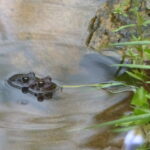Starting about mid-May when days and evenings began to warm up we’d hear off tune, extended croaking in damp spots around the yard, high in the trees, tucked into the woodpile and even on the side of the house. A few days later, high-pitched off-key trills burst from the little pond outside our bedroom window. It’s spring in Iowa and the tree frogs and toads are loving the moisture and warmth as they initiate their spring serenade.
Hyla Versicolor, or eastern Grey Treefrog, are fascinating amphibians. These diminutive creatures – about 2 and a half incles long – can change their rough, mottled skin within moments to better blend into their environment. Their large toe pads help them climb most surfaces, including buildings. Although they prefer woods’ edges, they also are found clinging to houses and even light posts! Once we spotted one clinging to our window. After mating, they tend to wander off into the forests to feed.
In winter they shelter under tree bark or leaves. A fabulous adaptation of changing glycerin to glucose that circulates through their organs prevents ice crystals from forming. Although remaining water freezes, they do not die. Come spring they thaw out to serenade us again.

Toads need water to mate.
The other night caller is the American Toad. Come dusk through the wee night hours, they sing merrily and mightily. They wander to the water to mate and reproduce, then they hop off to eat insects. They are especially helpful in gardens. Some of our friends even make toad habitats for them! Two protections protect these slow moving amphibians. A gland near their eyes secrets a nasty liquid that repels predators. This gland does NOT cause warts. That is just a silly story people tell kids for some reason. And they pee. When picking them up grasp them gently around the middle and hold them away from your body so you don’t get sprayed. Toadlets hatch by the hundreds a few weeks into summer and somehow make their way to safety. We hope you enjoy these late spring singers.

